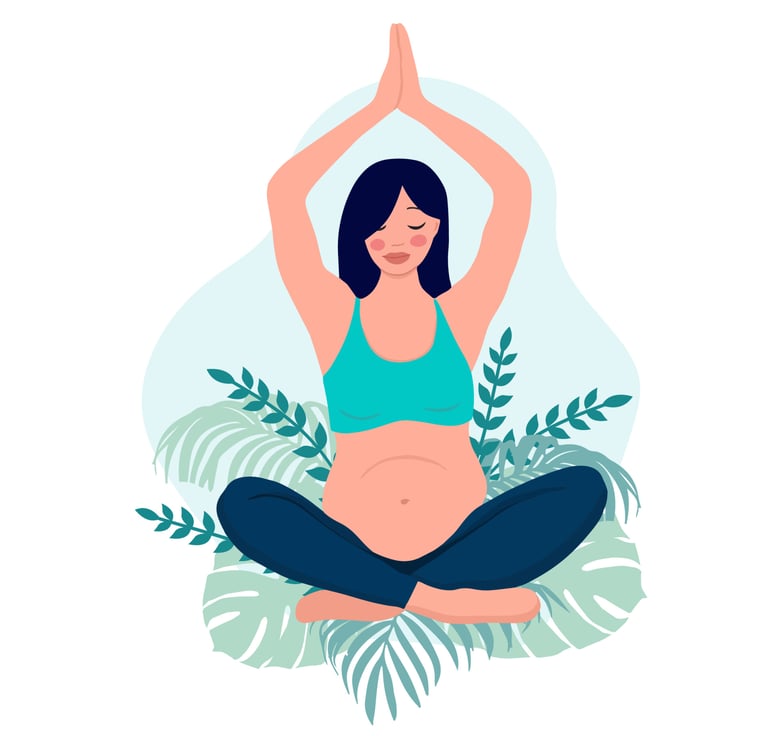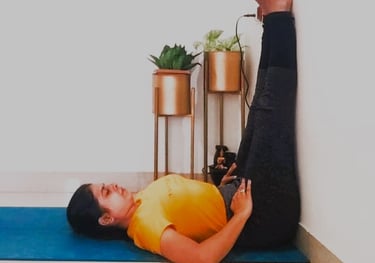Prenatal Yoga Routine 2024 :| Yognilay - Pune
Prenatal Yoga Routine 2024 A Comprehensive Guide for Expecting Mothers A specific type of yoga called "prenatal yoga". Why do pregnant women need yoga in their daily routine?


Introduction to Prenatal Yoga
Physical Benefits
Improved Flexibility and Strength
During pregnancy, a woman’s body undergoes significant changes that can lead to stiffness and discomfort. Regular yoga practice helps maintain flexibility and strength. These are essential for supporting the body through change. Gentle stretching exercises can reduce tightness. Strength-building poses can prepare the body for childbirth.
Reduced Back Pain and Other Discomforts
Back pain is a common issue during pregnancy due to the additional weight and changes in posture. Yoga poses that focus on stretching and strengthening the back muscles can provide relief. Yoga can also help reduce discomforts like swollen ankles, leg cramps, and fatigue. It improves circulation and promotes relaxation.
Better Posture and Balance
As the pregnancy progresses, the center of gravity shifts, which can affect posture and balance. Yoga encourages awareness of body alignment and helps maintain proper posture. Balancing poses can improve stability and prevent falls, which is especially important as the belly grows.
Benefits of Yoga During Pregnancy
Mental and Emotional Benefits
Stress Relief and Relaxation
Pregnancy can be a stressful time, filled with physical and emotional changes. Yoga incorporates deep breathing and mindfulness techniques that promote relaxation and reduce stress. These practices activate the parasympathetic nervous system, helping to calm the mind and body.
Improved Sleep
Many pregnant women experience sleep disturbances due to discomfort and anxiety. Yoga can help improve sleep quality by relaxing the body and mind. Gentle evening yoga routines can prepare the body for a restful night’s sleep, making it easier to fall and stay asleep.
Enhanced Mood and Reduced Anxiety
Hormonal changes during pregnancy can lead to mood swings and anxiety. Yoga’s focus on breath control and mindfulness helps regulate emotions and enhance mood. Regular yoga practice can lead to a positive outlook and less anxiety. This improves overall mental well-being.
Pregnancy is a beautiful journey, but it can come with its challenges. Prenatal care is crucial for the health and well-being of both the mother and the baby. One highly beneficial practice during pregnancy is yoga. When practiced regularly, yoga can improve physical and emotional health. It provides relief from common pregnancy discomforts. Online yoga offers pregnant women the flexibility to practice at home. This article explores how online yoga helps pregnant women every day. It highlights its benefits, daily routines, safety tips, and real-life success stories.
Why Choose Online Yoga?
Convenience and Accessibility
Practice from Home
One of the main advantages of online yoga is the ability to practice from home. This is particularly beneficial for pregnant women, who may find it challenging to travel to a yoga studio. Practicing at home provides a comfortable and safe environment where they can follow their own pace.
Flexible Scheduling
Online yoga offers the flexibility to practice at any time of day. Pregnant women can fit yoga into their schedules with a quick morning session or a relaxing evening routine. They don't need to worry about studio class times.
Daily Yoga Routines for Pregnant Women
Recommended Daily Practices
Gentle Stretching and Breathing Exercises
daily yoga practice should include gentle stretching and breathing exercises. These activities help maintain flexibility, reduce tension, and promote relaxation. Simple stretches like cat-cow, seated forward bend, and gentle twists can be very effective.
Safe Poses for Each Trimester
It’s important to adapt yoga poses to each stage of pregnancy. In the first trimester, focus on gentle stretches and avoid poses that put pressure on the abdomen. In the second trimester, it's good to add more standing poses and balance work. In the third trimester, focus on relaxation and preparing for childbirth.
Sample Daily Routine
Detailed Breakdown of a Typical 20–30 Minute Session
A typical daily yoga session for pregnant women might look like this:
Warm-Up (5 minutes): Gentle breathing exercises and seated stretches.
Main Practice (15–20 minutes): A mix of standing and seated poses, including cat-cow, warrior II, tree pose, and gentle twists.
Cool Down (5 minutes): Relaxation poses like child’s pose and savasana, focusing on deep breathing and mindfulness. Modifications for Different Stages of Pregnancy
As pregnancy progresses, it’s essential to modify poses to ensure comfort and safety. Use props like yoga blocks, straps, and bolsters for support. Avoid poses that require lying flat on the back after the first trimester and deep twists that compress the abdomen.
Safety Guidelines and Precautions
Prenatal yoga can help expecting moms feel better, reduce stress, and become more flexible. But it's important to follow safety rules. Before starting, talk to a healthcare provider to make sure there are no special concerns or issues


As the pregnancy progresses, modifications to the yoga routine become necessary. In the first trimester, it is advisable to avoid poses that involve deep twists, intense backbends, and inversions. Gentle stretching and focusing on breathing exercises can be beneficial during this period.
As you enter the second trimester, your body goes through many changes. It's important to avoid poses that involve lying flat on your back because this can press on a major blood vessel and reduce blood flow. Instead, side-lying positions and supported poses using props can provide comfort and safety.
In the third trimester, your growing belly can affect your balance. So, it's a good idea to modify or use support for poses that require strong balance It is also important to avoid poses that put pressure on the abdomen. Gentle stretching, pelvic floor exercises, and relaxation can be really helpful at this stage
Listening to your body is very important during prenatal yoga. If any pose makes you uncomfortable, dizzy, or short of breath, stop and rest. Get in touch with a medical expert as soon as you observe any warning symptoms, such as decreased baby movement, blood, or stomach discomfort. Prenatal yoga instructors are valuable because they know what pregnant women need and can give them extra attention.
Safety Tips for Practicing Yoga During Pregnancy
Consultation with a healthcare provider
Before starting any yoga practice, it’s crucial to consult with a healthcare provider. They can provide guidance on what exercises are safe and suitable for each stage of pregnancy.
Listening to Your Body
Pregnancy is a time to be extra attentive to the body’s signals. It’s important to listen to the body and avoid pushing beyond comfort limits. If a pose feels uncomfortable or causes pain, it should be modified or skipped.
Avoiding Certain Poses
Certain yoga poses are not recommended during pregnancy. Avoid poses that involve deep backbends, intense twists, and lying flat on the back after the first trimester. Poses that put pressure on the abdomen should also be avoided.
Using Props for Support
Props like yoga blocks, straps, and bolsters can provide additional support and make poses more accessible. They help maintain proper alignment and ensure comfort during practice.
Importance of Staying Hydrated and Well-Nourished
Hydration and nutrition are vital during pregnancy. It’s important to drink plenty of water before, during, and after yoga practice. Eating a balanced diet with sufficient nutrients supports overall health and well-being.
Importance of Proper Alignment and Breathing Techniques
Maintaining proper alignment in each pose is crucial to avoid strain and ensure safety during prenatal yoga. Use props such as blocks, bolsters, and blankets to support your body and accommodate changes in your center of gravity. Additionally, focus on your breath by practicing deep, belly breathing to help you relax and increase oxygen flow to you and your baby. You may have a healthier, more comfortable pregnancy and prepare your body for delivery by adopting these prenatal yoga poses into your regimen.


Creating a Prenatal Yoga Routine
Both new yogis and pregnant mothers might benefit from customizing their prenatal yoga practice. To begin with, setting a consistent schedule is crucial. Determine a time of day when you feel most energized and can practice without interruptions. Many find mornings or late afternoons ideal for yoga, as these times can help invigorate or unwind your body and mind, respectively.
Creating a comfortable and safe environment at home is another essential aspect. Ensure your practice area is free of distractions and clutter to create a calm space that helps with relaxation and focus.
Use a high-quality yoga mat and consider adding props such as bolsters, blocks, and straps to support various poses. Proper ventilation and natural lighting can further enhance your practice space.
Balancing yoga with other forms of prenatal exercise and rest is equally important. Prenatal yoga offers many benefits, such as better flexibility and less stress.
Adding low-impact activities like walking or swimming can make your fitness routine more complete.
Additionally, listen to your body and ensure adequate rest, as overexertion can lead to fatigue and discomfort.
A basic regimen for novices could include of easy stretches like Child's Pose, Cat-Cow, and a modified version of Downward-Facing Dog. These poses help build strength and flexibility while being gentle on the body.
Beginners can start with simple poses, while intermediate practitioners can add more complex ones.
Advanced yogis can try more challenging poses and balance moves to fit their changing bodies and bellies Creating a prenatal yoga routine involves thoughtful planning and a balanced approach.
Prenatal yoga helps more than just physical health. It greatly supports mental and emotional well-being. Breathing exercises and mindfulness help pregnant women manage stress and anxiety. They also help bond with the baby, relax, and prepare for childbirth.
Meditation in prenatal yoga helps mothers focus, reduce stress, and find calm.
These exercises improve oxygen flow, benefiting both the mother and baby.
and can be especially helpful during labor to manage pain and stay calm.
Mindfulness helps mothers stay present and be more aware of their bodies and babies.
Breathing exercises, like deep breathing, create calm and increase oxygen flow, benefiting both mother and baby.
They are also useful for managing pain and staying composed during labor.




Essential Prenatal Yoga Poses
Prenatal yoga offers expecting mothers a safe and beneficial way to maintain physical and mental well-being during pregnancy. Certain yoga poses, when done correctly, can alleviate common pregnancy ailments such as back pain, swelling, and fatigue, while also preparing the body for labor. Below are some essential prenatal yoga poses, categorized by their primary benefits and including modifications for different stages of pregnancy.




Bridge Pose
This pose helps to gently stretch and strengthen the spine, promoting mobility and easing postpartum back pain.




Switching from prenatal to postpartum yoga is important for new mothers. It’s best to be careful and patient, as your body changes after childbirth.
Most healthcare professionals suggest waiting until your six-week postpartum check-up before resuming yoga.
This may vary based on your delivery and personal situation.
Once your doctor says it's okay, you can begin gentle yoga to aid in recovery, build strength, and improve flexibility.
Postpartum yoga also helps manage stress and boosts well-being.
Mom-and-baby classes can be especially helpful because they allow you to bond with your baby while doing gentle exercises.
Many local studios offer postpartum classes, and there are online options to practice at home.
Online communities can offer extra support and resources.
Embracing postpartum yoga can help you recover, build strength, and create a positive environment for you and your baby.
Cat-Cow Stretch
Legs-Up Pose
Child's Pose
Excellent for strengthening the pelvic floor muscles and glutes, which are often weakened
during pregnancy and childbirth.
A restorative pose that promotes relaxation and helps alleviate stress and fatigue.
This pose aids in reducing swelling in the legs and feet and promotes relaxation.


”The prenatal yoga class was very helpful, as I could sense my baby's heartbeat activating in my abdomen while in Shavasana. I feel very lucky to have found such a receptive and helpful yoga instructor. and yognilay has taken sessions for ages via online”
- Shweta Awate-Pawale

Yoga for all
Stay fit with Yognilay and join a prenatal yoga session with us.
Provide diet chart
Monday-Friday session.
personal session on a low budget
customized as per student.
Register for a free demo session
Common Questions About Prenatal Yoga
Q1: Is it safe to practice yoga during pregnancy?
Yes, yoga is generally safe during pregnancy. However, it's important to talk to your healthcare provider and choose prenatal yoga classes made for pregnant women.
Q2: Can I practice yoga in the first trimester?
A: Yes, but focus on gentle stretching and avoid poses that put pressure on the abdomen. Listen to your body and modify poses as needed.
Q: Do I need any special equipment for prenatal yoga?
A: A good-quality yoga mat and props like blocks, straps, and bolsters can be very helpful. Ensure you have a comfortable and quiet space to practice.


